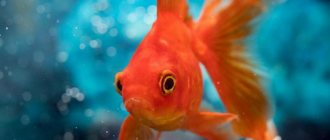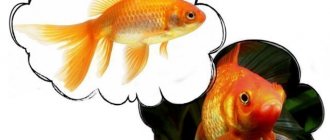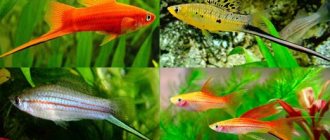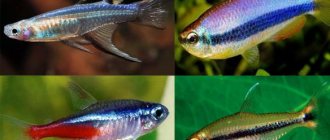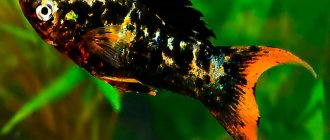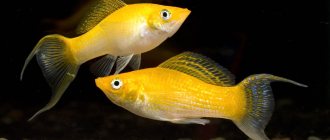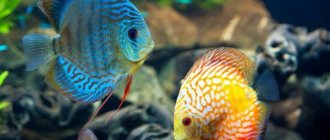Habitat
The goldfish we know today are the result of crossbreeding with goldfish, so they are not found in natural habitats.
These fish are a type of crucian carp that was artificially bred in China from silver crucian carp. The first mentions of it can be found in Chinese chronicles. The natural habitat of this species is the rivers of the southern Chinese provinces.
habitat of silver crucian carp
Silver crucian carp, which is the ancestor of all goldfish, was first distributed in the lower reaches of the rivers of the Aral Sea, reservoirs of Central Asia and Siberia. Later it was artificially resettled in many reservoirs in Europe and Siberia. At the beginning of the 16th century, goldfish were exported to Japan and China, where the fish served as a living decoration for the imperial gardens.
It is interesting that in some reservoirs only female goldfish lived, which crossed with males of related fish species (golden carp, roach, tench, carp, bream and others). Spermatozoa of related species stimulated the development of eggs, but no hybrids were formed. Only females were born that supported the existing population.
The original form of a goldfish
Goldfish and silverfish have many similar external characteristics. In some reservoirs they live together. Golden crucian carp is gradually replacing silver carp, plus they produce hybrids that can be found in some reservoirs.
Interestingly, in Australia, amateur aquarists released goldfish into natural reservoirs, where they grew to significant sizes. The largest representative weighed 1.9 kg.
It is worth saying that goldfish pose a serious threat to other inhabitants of the reservoir, because... They are quite voracious, eat plants, eggs of other fish, and become spreaders of infectious diseases.
A little bit of history
In Asia, as in Korea and China, goldfish appeared at least a thousand years ago. Thanks to the work of Chinese breeders, fish breeds with different shapes and color variations were developed, which have become the mainstay of many modern breeds.
The first written mention of goldfish with red scales dates back to the Jin Dynasty (China, 265-420 AD). The fish were discovered in one of the lakes of Mount Lushan.
Even the ancient Chinese treatise Shan Hai Jing, which according to scientists was written at the turn of our era, contains references to the “red crucian carp”. However, there is no reason to believe that these wild representatives are the ancestors of modern goldfish.
There is an assumption that the red color is the result of the breeding work of the very first pet lovers during the time when the Tang Dynasty ruled (618-907 AD).
According to one version, fish of unusual shapes and colors appeared due to the practice of Buddhism, which was widespread at that time. According to generally humane considerations accepted at that time, “ugly” fish were not destroyed, but were placed in farms and dams specially equipped for these purposes, as well as in decorative vessels and containers.
After the 960s, goldfish became pets in home pools.
Since the 13th century, the business of their mass breeding and sale has been actively developing.
From the 13th to the 16th centuries, goldfish as pets became available not only to the rich, but also to the poor. In Asia, goldfish appeared from the very beginning in Indochina, as well as countries neighboring China.
At the beginning of the 16th century they came to Japan. The inhabitants of this country are generally recognized leaders who have achieved considerable success in breeding goldfish.
Goldfish came to Europe in the 17th century.
Porcelain plate with underglaze blue and polychrome enamel; China, around 1760.
Porcelain vase with the image of goldfish. Jia Jing era (1522–1566), Ming dynasty. Kept in the Guimet Museum in Paris.
Main breeds of goldfish
Over thousands of years of painstaking breeding work, amateurs and fish breeders in Japan, China and other countries have developed many breeds, as well as variational varieties of goldfish.
Conventionally, all breeds can be divided into two types depending on body shape:
- long-bodied;
- short-bodied.
In total, several dozen are known (and according to some data, about 300 variations of breeds).
Here are examples of some of them:
Common goldfish (Carassius auratusm) - the body shape and fins follow the natural shape of the fish. They can grow up to 30 cm.
Butterfly (Goldfish Butterfly tail) - distinguished by the unusual color of forged non-ferrous metal, as well as a forked tail, the shape of which follows the wings of a butterfly. Reaches a size of up to 10 cm.
Fantail - distinguished by a raised upward or horizontal short tail, which when opened resembles a fan.
The veiltail is one of the artificially cultivated ornamental breeds of the aquarium “goldfish” (lat. Carassius gibelio forma auratus), which is known for its elongated fins and a longer, bushier veil tail - compared to other representatives of this species. Reaches sizes up to 20 cm.
Comet (Goldfish Comet) - has an elongated body and a tail fin in the form of a forked ribbon. The longer the fin of an individual fish, the more valuable it is. The average size of the fish is 10 cm.
Goldfish Bubble Eye An unusual breed that has a forked tail, as well as two bubbles hanging on the sides under the eyes, filled with liquid. The blisters can be up to ¼ the size of the body. When kept in an aquarium, the liquid bags may burst. The bags recover over time, but may vary in size. The fish can reach 13 cm, life expectancy up to 15 years.
Redcap Oranda Goldfish Has a white body and a characteristic bright red warty growth on the top of the head. The growth begins to form at 3-4 months of life, reaching its maximum size by 2 years. It is worth remembering that this breed is sensitive to temperature and water quality. The size of the aquarium fish is 15-20 cm.
Nymph (Fantail Goldfish) This breed of fish is often found in various exhibitions. A distinctive feature is the large caudal fin. The most valuable individuals have a “decoration” in the form of a forked tail. Most often, the fish are red-orange in color. The nymph is quite unpretentious in care; it can be kept in an aquarium, and in summer in open decorative ponds. The average size of fish in an aquarium is 10 -15 cm.
Lionhead Goldfish Has a rounded short body. Most of the fish’s head, sometimes the eyes, mouth and nostrils, are decorated with growths. Representatives of this species can have black, blue, red colors in numerous combinations. It is worth considering that this fish is quite slow; you should not place it next to active “neighbors” who can easily leave it without food. In an aquarium it reaches a size of up to 13 cm.
Ranchu (Ranchu Goldfish) Popular in Japan and China. It has a short rounded body, a wide back, strongly curved towards the tail. The classic coloration is a white body with specks, as well as red head growths. Due to the head tubercles resembling a raspberry, this breed is similar to the lionhead. Due to the unusual body shape, the fish cannot actively swim in the water column, so you should not choose active related breeds as “cohabitants”. It is best to keep the fish in an aquarium; in artificial ponds it may simply not survive due to low temperatures.
Ryukin Goldfish Considered to be the Japanese version of the Nymph. Both fish are bred from a common ancestor, but this variety has a high back, often called a hump. It starts at the neck area, thereby giving a tapered appearance when viewed from the side. The body itself is short, round in shape, the caudal fin is divided in two. There is a variant with very long fins called the Long-tailed Ryukin. The color can be different, monochromatic - red, orange, white, as well as a combination of several colors. For example, white coloration with numerous irregular spots of orange, red or brown is widespread. Reaches sizes up to 15 cm. They live 10-15 years.
How to help fish with overheating or hypothermia
In extreme situations, when due to accidental failure of equipment the optimal water temperature may be disrupted, there is very little time left to save the inhabitants. Therefore, measures must be taken very quickly. But most often there is no spare heater at hand, and every minute counts. If the water has cooled down too much, you can warm it up a little by adding warm, but not hot, liquid so that the changes occur smoothly, by 2°C in 15-20 minutes.
But you can add no more than 10% of fresh water from the total volume of the aquarium. If the warming is not enough, then a plastic bottle of hot water lowered into a pond can help. In the most critical situations, when time is lost and the fish are so frozen that they lie on the bottom, barely showing signs of life, you can pour vodka into the water in a volume of 20-30 ml per 100 liters of container.
Warming measures must be taken immediately. After the mode is restored, you will need to replace about 1/3 of the water to get rid of alcohol. Overheating is no less dangerous. An increase in temperature of 4°C from the usual is already dangerous for any species. The first aid in this case is maximum saturation of water with oxygen.
You can turn on the aerator or mix the water by hand, add 20-25 ml of hydrogen peroxide per 100 liters of volume. A bottle of cold water in the aquarium will also help reduce the temperature. To prevent infections and parasitic infestations as a result of decreased immunity in fish due to hypothermia or overheating, broad-spectrum drugs should be used.
Cichlids require keeping in warm water, since this water temperature produces the secretion of enzymes for a rich body color and stimulates them to spawn. Cichlids have a high tolerance for both high and low temperatures, but not more than 6 hours. The tank can be maintained at a medium temperature range. When cichlids are kept at elevated temperatures, their color quickly becomes saturated, but they become exhausted and live less.
At low temperatures, the color of cichlids fades, and the fry grow and develop slowly. The permissible temperature for keeping cichlids is 24-30 degrees. The limit is 24-27 degrees. For Tanganyika cichlids, the water should not be warmer than 29 degrees. When treating certain diseases of cichlids, to is increased for a while.
Cichlids are truly one of the hardiest fish in the aquarium; for a novice aquarist, many representatives of this family will be excellent pets. However, all types of fish require careful care, which should not be forgotten.
Conditions for keeping goldfish in an aquarium
In terms of care, we can safely say that goldfish are not so demanding in terms of their maintenance, but the owner must still have certain knowledge to ensure the fish a comfortable existence in the aquarium.
The first thing you need to take care of if you decide to buy a goldfish is the aquarium. Since ancient times, there has been a stereotype that goldfish look very beautiful in a small aquarium, which often does not even have soil, not to mention additional equipment. This opinion is fundamentally wrong!
All goldfish have large body sizes and also like to swim in small groups or schools. Based on these facts, it is worth choosing a suitable spacious aquarium.
The best solution would be to purchase a classic rectangular aquarium with a height of 45-50cm. Please note that the volume of the aquarium must be determined in this way: 1 goldfish requires at least 50 liters of water (for large varieties).
If you plan to keep breeds with a long body (for example, a comet), then an elongated “pond” would be ideal for them, allowing the fish to actively swim.
Equipment for an aquarium with goldfish
Although goldfish are very popular, it is very difficult to call them clean fish. They eat quite a lot and produce large amounts of waste. powerful filters in the aquarium where these beautiful aquarium representatives live . It is recommended to focus specifically on external ones, which most effectively combat various types of pollution.
need as such for a thermostat for a home pond with goldfish, since they prefer cool water that does not exceed 23°C, but it protects the fish from sudden drops in temperature, so it is still worth purchasing one.
a compressor since these fish need water enriched with oxygen. Please note that in a goldfish aquarium, live plants are practically not used. Read more about the reasons below.
Lighting. Goldfish have no specific requirements for the amount of light. Modern aquarium lighting with 6000-6500K lamps perfectly focuses attention on the bright colors of fish and their movement. Excessive light in an aquarium with goldfish can lead to an outbreak of algae growth, since quite a large amount of phosphates and nitrates accumulate in the water.
Water parameters
Goldfish are quite hardy, so they can be kept in water of varying hardness. To maintain stability and cleanliness in the aquarium, about 30% of the total water volume should be changed once a week.
Decorating an aquarium with goldfish
Ground and decorations. Since goldfish were selectively bred from goldfish, they inherited some of the habits of their ancestor, namely the love of digging at the bottom in search of something edible. Therefore, the soil fraction must be large, otherwise the fish may swallow it.
In addition to this, you can add decorations in the form of driftwood, shards, castles, pots and other things to the aquarium as decoration. This will decorate the pond, and the fish will be interested in swimming between them.
Vegetation. We have already written that it is not recommended to place live plants in an aquarium with goldfish.
Vegetation does not take root, because The fish are constantly stirring up the soil. In addition, the diet of these fish is very diverse: in addition to eating animal food, goldfish are not averse to eating plants that are rich in fiber.
The types of vegetation that will not become food for goldens can be counted on one hand: echinodorus, anubias, etc., these are mainly hard-leaved species
Feeding goldfish
Feeding is perhaps one of the most important elements of the keeping system for any type of fish. Despite the fact that the diet of goldfish should be varied. It is not recommended to use frozen and live food on an ongoing basis, because they quite often cause diseases of the gastrointestinal tract and obesity due to their high protein content.
It is important to understand that the ideal ratio of components for gold is: 30% protein component and 70% plant food.
Types of feed:
- Flakes. This food is suitable for absolutely all breeds of goldfish. It improves the health of fish due to the content of all necessary elements;
- Compact sticks. Due to its appearance, the food is very convenient and easy to dose.
- Granular feed. It’s just as good as flakes, the only downside is that some species drown quickly; on the other hand, it gives fish the opportunity to comb the soil in search of leftover food, satisfying their natural habits.
- Frozen and live food. These foods are suitable for all fish; it is important to consider the size of the food and the percentage in the diet for each species of aquarium inhabitants.
- Plant food . Floating plants are often specially grown for goldfish, which are subsequently fed. Such plants include duckweed, naiad, wolfia, riccia, hornwort, and vallisneria. In addition, you can use finely chopped lettuce, nettle, spinach, dandelion, and cabbage leaves.
Goldfish are playful and very voracious creatures. They should be fed 1-2 times a day, in no case more often. If it seems to you that the fish are hungry, despite the fact that you fed them an hour ago, you should not be provoked: goldfish, like many others, do not have a feeling of fullness, and overfeeding can lead to disastrous consequences for the aquarium and for its inhabitants.
Diseases and their prevention
Like all living things, goldfish get sick. In sick individuals, the dorsal fin is compressed, the scales are protruding, the stomach is swollen, and the eyes protrude. In addition, their appetite decreases and lethargy appears. This often happens due to incorrect content. Every water contains parasites and pathogens.
With proper care, the immune system of fish is able to repel attacks from harmful microorganisms. When an aquarium resident constantly experiences stress due to unfavorable factors (incorrect temperature, wrong food, wrong water acidity, overcrowding of the tank, aggressive neighbors), this weakens his immunity and leads to illness.
Early treatment promotes recovery. When the fish gets sick, it should be moved to another container with a water volume of 35-50 liters and kept there for at least a month.
If your pet's condition is satisfactory, you may not give him medication. In severe cases, drugs should be added to water.
Compatibility with other types
When choosing neighbors for goldfish, you should take into account that successful coexistence is influenced not only by the type of fish, but also by a number of other factors - the volume of the aquarium, for example, its population density, etc.
As for the direct selection of species for proximity to goldfish, there are three categories of fish.
Compatible Types
Other breeds of goldfish. A species aquarium with several breeds of goldfish is perhaps the ideal solution.
- Firstly, care is simplified, since they require the same conditions of maintenance and feeding.
- Secondly, an aquarium with such inhabitants will look very impressive. There is only one additional condition: short-bodied and long-bodied golden breeds should not be placed in the same aquarium.
Koi carp. A tandem of long-bodied goldfish and pond koi carp is quite appropriate and looks quite impressive. An important condition is an aquarium of suitable size. As an option, such a company can be settled in a decorative pond.
Corridors. The peaceful nature of Corydoras makes them compatible with a wide range of aquarium fish species, including goldfish. The only thing you should pay attention to when choosing such a neighborhood is whether the temperature regime for keeping specific types of goldfish and corydoras matches, as well as the size of the neighbors.
Torakatums. Thorakatum catfish also have a very peaceful character and get along well with goldfish. They never come into conflict with each other, since they occupy different niches in the underwater world.
Species relatively compatible
Molliesia . The fairly large size of mollies does not give reason to worry about their safety in such a neighborhood - they are unlikely to fit in the mouth of a goldfish. On the other hand, they have a non-aggressive nature and do not tend to bite the tails of goldfish.
Gourami . The proximity of goldfish to these representatives of labyrinthine fish can be ambiguous. Often, gourami are quite peaceful and get along well with representatives of other species in the same aquarium. But there are situations when individual individuals behave aggressively and literally terrorize the entire aquarium. Neighborhood with such a “terrorist” will be unfavorable for goldfish.
Tetras . There is a real idyll between goldfish and tetras; conflicts never arise between them. But this situation persists exactly until the young goldfish grow to their adult sizes. It will not be difficult for them to eat a tetra and most likely they will take advantage of this opportunity.
Danio . These attractive zebra fish are peaceful, do not enter into conflicts with goldfish and have similar living conditions. But the balance is destroyed as soon as the goldfish grow up and become potential food for them.
Incompatible species that are strictly not recommended for proximity:
Barbs . These fish are not indifferent to the bushy tails of goldfish and will constantly hunt for them. They are able to literally bite them off, leaving only one skeleton.
Guppy . There are several reasons to avoid keeping guppies close to goldfish. Firstly, their maintenance requires different temperature conditions. Secondly, the small size of guppies makes them easy prey. And goldfish are not averse to plucking the tails of males.
Angelfish . In size, both of these types of fish are quite comparable, but experienced aquarists do not recommend such a proximity. Angelfish will not miss the opportunity to bite the fins of goldfish and will constantly chase them around the aquarium.
African cichlids . These inhabitants of African rivers have a very aggressive character. They will not give rest to the goldfish and will constantly attack them.
American cichlids . Representatives of American cichlids are no less aggressive. They basically view goldfish as food and will eat them out very quickly if they live together.
Swordtails . They have gained the unsightly reputation of being fans of biting their neighbors' fins. Therefore, goldfish will not be comfortable with them.
Discus fish . The conditions for keeping discus fish and goldfish are very different. If the ideal water temperature for discus fish is 30-32 °C, then for goldfish this temperature regime is unacceptable. Therefore, such a neighborhood should be excluded.
The temperature must be monitored
Experienced aquarists have long protected themselves from such troubles as the need to lower or increase the degrees. To keep fish within optimal temperature limits, the following rules should be taken as a basis.
- Choose the “right” place for the aquarium: away from heating devices, air conditioners, away from direct sunlight (especially in summer) and drafts.
- The heating pad must be of high quality and have a reliable sensor.
- A thermometer is a must-have device for any aquarium. Select its location so that it is convenient to monitor the scale indicators.
- Aeration is not a fad, so the compressor should be turned on regularly. Without enough air, what kind of habitat would be comfortable?
INTERESTING ARTICLES:
- Water hardness in an aquarium: how to increase and how to decrease
- Dutch Aquarium - description, photo, video
- Amano Takashi Aquarium - an amazing underwater world
- Vitamins for aquarium fish - overview of types
- The main mistakes of beginner aquarists
- Quarantine of aquarium fish - description
- DIY aquarium repair at home
- Water conditioner for an aquarium: how to use, description, photo
- Aquarium timer: description, photo, video, review
- Aquarium in an apartment according to Feng Shui - description photo video
- Aquarium fish scattering eggs.
- What should you do with the aquarium if the room is being renovated?
- Stones for an aquarium: types, description, photo, design, design, video
- All about water in the aquarium - chemistry ph peat extract ppm redox potential
- How to choose an external filter for an aquarium?
